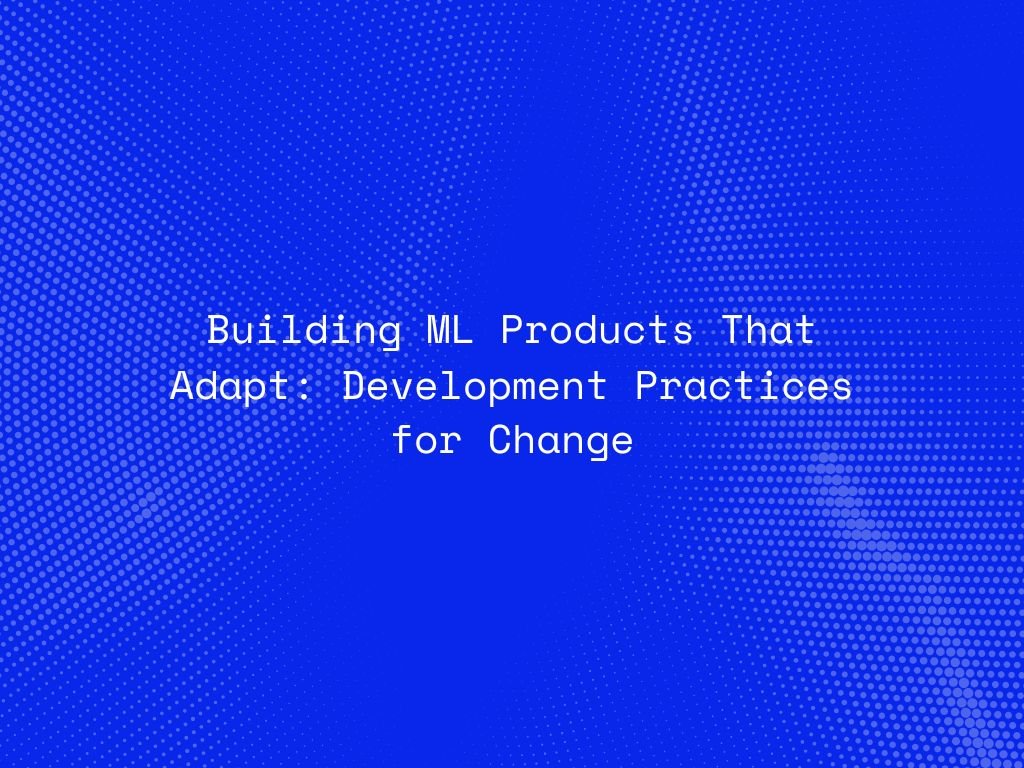In the rapidly evolving landscape of artificial intelligence, machine learning (ML) products must do more than just perform well at launch — they must adapt continuously to new data, conditions, and user expectations. Static models quickly lose relevance in a dynamic world where trends shift, behavior changes, and systems evolve.
To build ML products that adapt, teams need to rethink traditional development practices and adopt strategies that embed flexibility, learning, and evolution into the very fabric of the product lifecycle.
1. Embrace Continuous Learning Over Static Modeling
Traditional software development follows a “build, test, deploy” cycle. In ML, this isn’t enough. Models must learn and improve continuously as new data becomes available.
Implementing continuous training (CT) pipelines allows your system to automatically retrain models on fresh data while maintaining version control and performance tracking. Combined with MLOps practices, this creates an environment where models evolve alongside the problem space — ensuring relevance and resilience.

2. Build Robust Data Pipelines for Dynamic Inputs
Adaptable ML products depend on reliable, scalable data pipelines. When data sources change — new sensors, APIs, or user interactions — your pipelines should integrate them seamlessly without breaking the model workflow.
Use data validation, drift detection, and automated feature engineering to ensure that incoming data remains clean and relevant. Monitoring for data drift and concept drift (changes in data distribution or meaning) helps detect when retraining is necessary.

3. Design for Modularity and Reusability
Adaptation begins at the design level. Instead of building monolithic ML systems, opt for modular components — separate data ingestion, preprocessing, model training, and deployment layers.
This modularity makes it easier to swap models, upgrade algorithms, or test new features without disrupting the entire system. It also supports rapid iteration, a must for businesses operating in dynamic markets.

4. Leverage Feedback Loops for Real-World Learning
The best ML products learn not just from data, but from user interactions and outcomes. Establish feedback loops that capture how users respond to AI-driven outputs — for example, which recommendations they click, which alerts they ignore, or how they rate automated insights.
This real-world feedback can guide reinforcement learning or active learning systems to refine predictions and improve decision-making. Over time, your model becomes more aligned with user intent and context.

5. Prioritize Explainability and Interpretability
Adaptation shouldn’t come at the cost of transparency. As ML products evolve, business teams must still understand how and why models make decisions.
Incorporate explainable AI (XAI) techniques such as SHAP or LIME to make model predictions interpretable. This not only builds trust with stakeholders but also helps detect biases or anomalies that may emerge as models evolve.

6. Implement Rigorous Monitoring and Alerting Systems
To maintain adaptability, you need visibility. Continuous model performance monitoring tracks metrics like accuracy, precision, and recall, while data drift detection alerts you to changes that may degrade model quality.
Tools like MLflow, Evidently AI, or custom dashboards can automate alerts when thresholds are breached. This ensures teams can act proactively — retraining or tuning models before they fail.

7. Encourage Cross-Functional Collaboration
Adaptable ML products require collaboration across data science, engineering, operations, and product teams. Regularly align business goals with model metrics to ensure your system adapts not just technically, but strategically.
Establish clear feedback channels between model developers and domain experts so the model’s evolution reflects real-world priorities.

8. Adopt Responsible AI and Governance Practices
As your ML systems evolve, so do their potential impacts. Ethical considerations like bias detection, fairness, and compliance must remain part of the adaptation process.
Embed responsible AI frameworks into your development lifecycle. This includes audit trails, ethical risk assessments, and fairness testing to ensure evolving models stay aligned with your organization’s values.

Conclusion
In an ever-changing business environment, adaptability is the ultimate competitive advantage. Building ML products that evolve intelligently requires a foundation of continuous learning, modular design, feedback-driven improvement, and ethical governance.
By integrating these principles, enterprises can move beyond static models and create AI systems that thrive in change — not merely survive it.
The future of AI belongs to those who can adapt fast, learn faster, and evolve responsibly.




